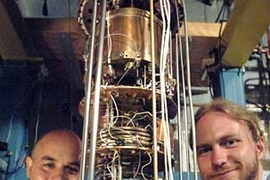CAMBRIDGE, Mass. - MIT physicists have developed a spectroscopy technique that allows researchers to inspect the world of electrons confined to a two-dimensional plane more clearly than ever before.
Two-dimensional electron systems, in which electrons are walled in from above and below but are free to move in a plane as if they were placed on a sheet of paper, are rarely observed in the natural world. However, they can be created in a laboratory and used, for example, in high-frequency amplifiers found in cell phones.
The new spectroscopy technique measures electron energy levels with 1,000 times greater resolution than previous methods, an advance that has "tremendous power to tell you what the electrons are doing," said MIT physics professor Ray Ashoori, author of a paper on the work published in the July 12 issue of Nature. This technique has already revealed some surprising behavior, and the researchers believe it will shed new light on many physical phenomena involving electrons.
Ashoori and postdoctoral associate Oliver Dial took advantage of a quantum phenomenon known as tunneling to create the most detailed image ever of the spectrum of electron energy levels in a 2D system.
The new spectroscopy technique relies on a phenomenon that defies the laws of classical mechanics. Electrons, because they exhibit wavelike behavior, can move between two locations separated by a barrier without having to pass over the barrier--a phenomenon known as "quantum tunneling."
"We anticipate that this technique will help us discover all kinds of new physics," said Ashoori. "We're looking into a realm that was just not visible to us before."
Electrons trapped in 2D systems exist in specific energy levels, just as electrons orbiting an atom's nucleus in three dimensions exist in distinct quantum energy levels. By measuring which energy levels are occupied, physicists can study how electrons behave together in large groups.
The researchers used short pulses of electricity to induce electrons to tunnel from a 2D system to a 3D system, and vice versa. By measuring the resulting voltage difference, they could calculate the energy states of the electrons in the 2D system.
The spectroscopy experiments were performed inside a semiconducting crystal cooled to 0.1 degrees above absolute zero.
Until now, the primary method for performing this kind of spectroscopy relied on photoemission. The new method has an energy resolution that is 1,000 times finer than the best photoemission measurements.
Physicists have also traditionally used "transport" techniques that measure electrical currents flowing in response to applied voltages to learn about 2D electron energy levels, but that technique only offers a partial look at what electrons are doing.
"Similar to creating small ripples on the surface of a sea, transport techniques only tell us about what is happening very close to the water's surface," said Dial. "Pictures made with this high-resolution spectroscopy provide, in essence, one of the first glimpses of the entire ocean in these systems and show what a beautiful and interesting world exists beneath the surface."
The research was conducted in collaboration with crystal growers at Alcatel-Lucent Bell Laboratories in Murray Hill, N.J., and funded by the Office of Naval Research and the National Science Foundation.
A version of this article appeared in MIT Tech Talk on September 12, 2007 (download PDF).









